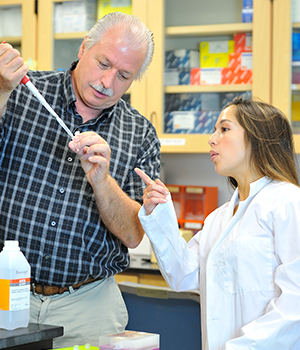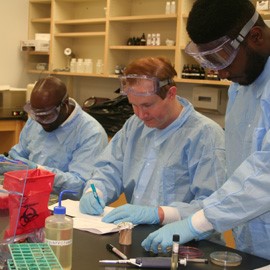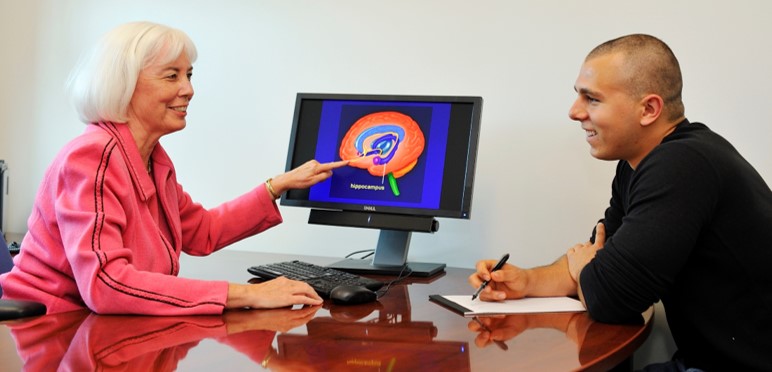This year many Biological Sciences Department faculty members are altering their teaching strategies to improve student learning and success in many undergraduate Biology courses including Genetics, Principles of Ecology, Human Morphology and Function, Human Neuroanatomy, and the Small World Initiative (SWI) Life Science laboratory. Their innovative strategies involve implementing better technology and online interactive resources, in-class activities and exercises designed to engage students and improve comprehension, targeting lecture material to focus on challenging topics, and real-world applications that allow students to understand how learned concepts apply to practical situations and problem-solving skills.
 For two consecutive years,
Dr. David Binninger
has employed Top Hat, a web-based classroom response system, in the Genetics (PCB 3063) course. This system offers a range of question formats that is superior to traditional iClicker, which is limited to multiple choice questions. In addition, Top Hat allows students to see the lecture slide on their device while the slide is on the auditorium screen. Dr. Binninger feels that this system helps the students be more engaged and improves attendance. In fact, 88% of the students who started the course using Top Hat answered the last question on the last lecture in the fall 2017 semester. Overall, he has seen that the student response to Top Hat has been very encouraging with positive comments clearly outnumbering negative ones on the SPOT evaluations. In addition to better attendance, there has been a slight upward trend in the average raw exam scores as well as the percentage of students who earned a passing grade in the course (C- or better) since it was transitioned from the traditional iClicker to Top Hat system. In classes of this size where the average enrollment is above 300 students, an 8% increase in the pass rate translates to approximately 30 more students successfully completing the course.
For two consecutive years,
Dr. David Binninger
has employed Top Hat, a web-based classroom response system, in the Genetics (PCB 3063) course. This system offers a range of question formats that is superior to traditional iClicker, which is limited to multiple choice questions. In addition, Top Hat allows students to see the lecture slide on their device while the slide is on the auditorium screen. Dr. Binninger feels that this system helps the students be more engaged and improves attendance. In fact, 88% of the students who started the course using Top Hat answered the last question on the last lecture in the fall 2017 semester. Overall, he has seen that the student response to Top Hat has been very encouraging with positive comments clearly outnumbering negative ones on the SPOT evaluations. In addition to better attendance, there has been a slight upward trend in the average raw exam scores as well as the percentage of students who earned a passing grade in the course (C- or better) since it was transitioned from the traditional iClicker to Top Hat system. In classes of this size where the average enrollment is above 300 students, an 8% increase in the pass rate translates to approximately 30 more students successfully completing the course.
 Last spring,
Dr. Dale Gawlik
implemented his preparation to “flip” his large enrollment Principles of Ecology (PCB 4043) course. Dr. Gawlik dropped the textbook and adopted a completely online interactive resource. The online material included a combination of electronic text and a set of interactive computer simulation models that allows students to test hypotheses using models. He implemented a weekly online assignment with questions and activities that he would use to create targeted lectures focusing on the material in which students scored less than 70% in the previous week's online assignment. This strategy allowed Dr. Gawlik to focus class time on the <25% of material that students did not understand to improve their comprehension of difficult topics and overall test scores. He got the students more engaged in the lectures by heavily integrating iClickers and the “think-pair-share” technique, where students are allowed to spend a few minutes discussing it with their neighbor and then retested. In addition to these teaching strategies, Dr. Gawlik also used the beginning of each lecture to highlight an application of ecology related to a hot topic in the news, allowing students to connect the content they were learning with practical situations and real-life problem solving techniques.
Last spring,
Dr. Dale Gawlik
implemented his preparation to “flip” his large enrollment Principles of Ecology (PCB 4043) course. Dr. Gawlik dropped the textbook and adopted a completely online interactive resource. The online material included a combination of electronic text and a set of interactive computer simulation models that allows students to test hypotheses using models. He implemented a weekly online assignment with questions and activities that he would use to create targeted lectures focusing on the material in which students scored less than 70% in the previous week's online assignment. This strategy allowed Dr. Gawlik to focus class time on the <25% of material that students did not understand to improve their comprehension of difficult topics and overall test scores. He got the students more engaged in the lectures by heavily integrating iClickers and the “think-pair-share” technique, where students are allowed to spend a few minutes discussing it with their neighbor and then retested. In addition to these teaching strategies, Dr. Gawlik also used the beginning of each lecture to highlight an application of ecology related to a hot topic in the news, allowing students to connect the content they were learning with practical situations and real-life problem solving techniques.
 Dr. Diane Baronas-Lowell
is leading the Small World Initiative (SWI) in Life Science for non-STEM majors by redesigning the laboratories with research and inquiry-based pedagogies that focus on enhancing student critical thinking skills and real world applications such as creating novel antibiotics. Since students in Life Science randomly choose their lecture and lab sections, students in SWI and traditional labs are distributed across the three lecture sections each semester. Dr. Baronas-Lowell is developing conceptual questions for use by all Life Science instructors to determine if SWI lab students will differ from traditional lab students in regards to their critical thinking skills over the course of the semester. Guidance in this assessment is being sought in an on-going collaboration with Nancy
Dr. Diane Baronas-Lowell
is leading the Small World Initiative (SWI) in Life Science for non-STEM majors by redesigning the laboratories with research and inquiry-based pedagogies that focus on enhancing student critical thinking skills and real world applications such as creating novel antibiotics. Since students in Life Science randomly choose their lecture and lab sections, students in SWI and traditional labs are distributed across the three lecture sections each semester. Dr. Baronas-Lowell is developing conceptual questions for use by all Life Science instructors to determine if SWI lab students will differ from traditional lab students in regards to their critical thinking skills over the course of the semester. Guidance in this assessment is being sought in an on-going collaboration with Nancy  Romance, Ph.D., Professor (Education). In addition to using techniques designed to enhance critical thinking skills, Dr. Baronas-Lowell initiated a collaboration to incorporate SWI into other undergraduate laboratory courses in the College of Science. In late December 2017, a collaboration was initiated with Lyndon West, Ph.D., Associate Professor (Chemistry and Biochemistry), Daniela Scheurle, Ph.D., Coordinator, Academic Support Services (Biological Sciences), Shweta Singh, Ph.D., Post-doc, Paul Scesa, Ph.D. candidate and Alexis Martin, DIS student, on incorporating bacteria found in RI:BSC 1005L/SWI labs into other undergraduate courses, including undergraduate General Microbiology Labs. This collaboration will also conduct proof of concept experiments for possibly incorporating bacteria organic extracts into Biological Principles Labs, General Chemistry Labs, Organic Chemistry Labs and Biochemistry labs. This collaboration hopes to eventually engage many undergraduate students in genuine research across the Charles E. Schmidt College of Science’s Curriculum.
Romance, Ph.D., Professor (Education). In addition to using techniques designed to enhance critical thinking skills, Dr. Baronas-Lowell initiated a collaboration to incorporate SWI into other undergraduate laboratory courses in the College of Science. In late December 2017, a collaboration was initiated with Lyndon West, Ph.D., Associate Professor (Chemistry and Biochemistry), Daniela Scheurle, Ph.D., Coordinator, Academic Support Services (Biological Sciences), Shweta Singh, Ph.D., Post-doc, Paul Scesa, Ph.D. candidate and Alexis Martin, DIS student, on incorporating bacteria found in RI:BSC 1005L/SWI labs into other undergraduate courses, including undergraduate General Microbiology Labs. This collaboration will also conduct proof of concept experiments for possibly incorporating bacteria organic extracts into Biological Principles Labs, General Chemistry Labs, Organic Chemistry Labs and Biochemistry labs. This collaboration hopes to eventually engage many undergraduate students in genuine research across the Charles E. Schmidt College of Science’s Curriculum.
 Last year,
Dr. Brenda Claiborne
modified all of her lectures for Human Morphology and Function 1, Human Morphology and Function 2, and Principles of Human Neuroanatomy to include in-class exercises in every session with the intent of engaging students more fully in the classroom and obtaining “real-time” feedback on lectures. Dr. Claiborne employed this because she found that students performed much better on exams and quizzes on those topics that they worked with in class and because the students themselves stated that the in-class exercises helped them learn the material. The results were so encouraging that Dr. Claiborne began incorporating in-class exercises in each class, which required rewriting lectures as well as composing numerous handouts and exercises. Importantly, after observing the students’ progress as they worked through the exercises in class, she was able to correct misconceptions or elaborate on difficult concepts before the end of the class period. Additionally, she found that one of the most useful exercises was simply to have the students sketch or draw the process or structure that was just discussed. In Human Neuroanatomy last Spring, she asked the students to draw each circuit (or pathway) in class, either as they were going through it or immediately afterwards. Since this strategy worked so well, she adopted the same approach in other courses such as Human Morphology and Function 1. Visualizing a process or structure (which underlies the ability to recreate/draw the process or structure on paper) has not only been a source of continual amazement but has also proven an effective tool for helping improve student comprehension of advanced concepts.
Last year,
Dr. Brenda Claiborne
modified all of her lectures for Human Morphology and Function 1, Human Morphology and Function 2, and Principles of Human Neuroanatomy to include in-class exercises in every session with the intent of engaging students more fully in the classroom and obtaining “real-time” feedback on lectures. Dr. Claiborne employed this because she found that students performed much better on exams and quizzes on those topics that they worked with in class and because the students themselves stated that the in-class exercises helped them learn the material. The results were so encouraging that Dr. Claiborne began incorporating in-class exercises in each class, which required rewriting lectures as well as composing numerous handouts and exercises. Importantly, after observing the students’ progress as they worked through the exercises in class, she was able to correct misconceptions or elaborate on difficult concepts before the end of the class period. Additionally, she found that one of the most useful exercises was simply to have the students sketch or draw the process or structure that was just discussed. In Human Neuroanatomy last Spring, she asked the students to draw each circuit (or pathway) in class, either as they were going through it or immediately afterwards. Since this strategy worked so well, she adopted the same approach in other courses such as Human Morphology and Function 1. Visualizing a process or structure (which underlies the ability to recreate/draw the process or structure on paper) has not only been a source of continual amazement but has also proven an effective tool for helping improve student comprehension of advanced concepts.